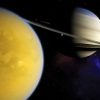Saturn's Magnetosphere and Titan
In another blog, we discussed the various magnetic fields emitted by planets in our solar system. This time, we’re going to take a closer look at Saturn. Specifically, its magnetosphere and its effect on Titan, Saturn’s largest moon.
With the recent discovery of Proxima B, just four light years from Earth, the quest to find a new habitable planet among the stars has been refueled. For a long time, another contender was Titan because it meets a lot of criteria. For one thing, it has an atmosphere similar to what Earth’s looked like millions of years ago. Another huge boon is the possibility of water. Although much farther from the sun, craters formed by large asteroids could remain in liquid form and potentially sustain life.
However, there is one very, very large problem: Saturn. The second largest planet in the solar system, Saturn is also armed with a pretty impressive weapon—its magnetosphere. Saturn’s magnetosphere is the second largest object in the entire solar system, only smaller than Jupiter’s. The magnetosphere extends into space for a little over 101,000 miles and performs many of the same functions as Earth’s magnetic field. It blocks solar wind and its radiation and even creates auroras at Saturn’s poles.
However, one unpleasant side effect of Saturn’s magnetosphere is that it pretty much guarantees life could not survive on Titan or any other of its major moons.
For one thing, Titan does not have its own strong magnetic field, leaving it almost defenseless to the whims of the solar system. Saturn’s magnetosphere acts like a giant vacuum, basically sucking up Titan’s atmosphere. All the gases, including those needed to sustain life like hydrogen and nitrogen, are ripped away from moon in the form of plasma. Without a strong magnetic field or atmosphere, it’s very difficult to sustain life.
The other reason Titan probably can’t become the next Earth is again related to its lack of a magnetic field. Saturn takes Titan’s atmosphere, but gives it its magnetism. With no magnetic field to repel the planet, Titan is forced to endure whatever Saturn throws at it. As Titan orbits closer to Saturn, this magnetization gets stronger, wreaking havoc on Titan’s atmosphere and weather. It also mean that if there were oceans of water on Titan, that be subject to some pretty catastrophic turbulence.
Unfortunately, it doesn’t look like Titan will be colonized any time soon. Because of Saturn’s magnetosphere, life on Titan would be far too difficult to establish and too unpredictable to maintain. We’ll just have to keep looking.
Image by Kevin Gill

